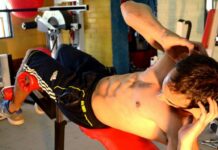We often take for granted how perfectly designed our human body is. It is enough to take a look at our hands to understand that without them everything would be much more difficult.

In fact, even a simple finger is important in our body. Every part of us is placed there for a definite purpose. Not simply by chance, as some sympathizers of evolutionary theories would have we believe.
Let’s just imagine what our life would be like if we didn’t have eyes, if everything tasted the same to us, if we could only see in black and white or similar things. We could really go on living, but would we enjoy life just as much? Probably not. So this lets us see that we are wonderfully made.
However, sometimes we are dissatisfied with some part of our body. For example, we would like to have more buttocks, more defined legs, stronger and thicker biceps, and firmer busts. If we think about it carefully, all these characteristics are related to our muscles.
Usually when we think of muscles we associate them with strength and it certainly has something to do with it. However, it is not the only thing they can do. Muscles are responsible for other functions in our body.
For that reason, in order to treat it as well as possible, we will be talking about how the muscular system of the human body works. If you know how this great machinery works, then you will be aware of what to avoid and what to do to keep it in the best possible condition.
So you can’t stop reading this article. Which is dedicated to our muscular system and each of the functions for which it is responsible? At the end of the reading, you will feel grateful for this wonderful gift that you have received and, as such, you will want to take good care of it.
Instructions for the muscular system
Muscles are a tissue which is made up of cylindrical fibers that, at the same time, are made up of filaments that can be thin or thick.
These fibers are positioned next to each other and are joined by connective tissue. These, in turn, form the tendons that are responsible for holding the muscles of the bones together. This type of tendon is called the tendon of origin.
However, not all muscles are attached by tendons. Some are thanks to other muscles or even the skin, as is the case with the muscles of the face.
In addition, the tendons are the ones that have the contraction force of the muscle and pull on it in order to create movement and give stability to the joints or the union of the bones.
We can divide the functioning of our muscular system into three processes: a voluntary one, an involuntary one and finally, an autonomous one.
In our body we can find the skeletal muscles, which adhere to our bones and move either voluntarily or by reflex. That’s why when we’re sitting down and our knee is lightly tapped, we often make an involuntary leg-lifting movement called a Reflex.
These muscles are what help you perform movements that keep you alive. For example: Walking, running, taking something with your hand, moving objects, lifting some weight, playing a sport, cooking, getting out of bed, etc. Without skeletal muscles none of this would be possible.
These movements are produced thanks to the types of fibers that compose it:
- First of all, we have the nerve fiber or type 1 fiber, these are responsible for causing a rapid contraction but with little resistance, due to the energy that is stored in the mitochondria.
- On the other hand, there is the muscle fiber or type 2 fibers which, on the contrary, provide a slow but high resistance contraction, due to the fact that they have the capacity to store a large amount of energy.
In our body there is also the heart muscle which, as its name indicates, is only found in the heart. This has mixed characteristics; we could say that it is the union of the features of smooth and skeletal muscles, in order to generate the particular heart rate.
Since the heart never stops, the cells of its fibers contain more mitochondria in order to ensure its resistance. In addition, they contain pacemaker cells, which are responsible for coordinating the heart rate.
Finally we could name the smooth muscles. This type of muscle is self-contracting. It is made up of the entire digestive system. Thanks to this muscle, our body is able to transport food throughout the digestive system, absorb nutrients and cause contractions so that waste material is expelled from the body in the form of feces.
So, the entire body is made up of about 600 muscles and about 1200 tendons. Due to this, they make up 40% of the total weight of our body. Of course, this percentage can vary depending on the physical activity we do and the diet we have.
What do you need for the muscular system?
As we have already pointed out before, the functioning of the muscles occurs through the contraction or relaxation of the muscle fibers. If these relax, the muscle lengthens and produces movement. On the other hand, if the fibers contract, the muscle shortens.
The movement by elongation occurs in two ways: The first, voluntarily, due to indications provided by motor neurons and the second, involuntarily, which lead to the functioning of the different organs and even the reflexes of the human body.
It is well known that muscles need activity in order to keep their fibers healthy. But, what happens when there is an absence of activity? Hypertrophy occurs. In other words, the muscles atrophy and muscle mass is lost.
The opposite is also true, when we expose our muscles to a lot of effort, they hypertrophy. That is, the muscle cells grow and, therefore, the muscle fibers increase considerably in size.
Just like a musical orchestra, our muscular system works in perfect harmony with the rest of the human body. Thanks to the motor activity of the muscles, it is possible for our heart to work. But not only that, but also the blood and lymphatic vessels, the lungs, the stomach, the bladder, the uterus, the intestines, etc.
On the other hand, thanks to the muscular system we can have stability in our body, since it is in charge of controlling the balance in everything we do. In addition, it is responsible for expressing our emotions through the gesticulation of facial muscles.
The muscular system is also closely related to the nervous system, since it not only allows us to move voluntarily, it is also responsible for protecting our body by increasing its temperature to produce heat.
For example, when we shiver when we are cold, it is because the nervous system indicates that the temperature is dropping, so the muscles begin to contract to produce heat in response.
It is also important to indicate that the muscular system, along with the nervous, bone and joint systems make up the motor system.
Tips for the muscular system
In view of the importance of our muscular system, we must be aware of the correct way to take care of it, how can we do it?… One way to achieve healthy muscles is by maintaining a balanced diet.
This means that you should limit the consumption of high-fat foods, since these generate overweight. When this happens, you add extra tension to the muscles, which increases the possibility of a muscle tear, among many other negative situations.
Foods rich in potassium help in the prevention of muscle cramps and contractures. Some of these foods are bananas, plums, and walnuts.
On the other hand, foods rich in iron and calcium will help keep muscle fibers in good condition. Some of the foods with these properties are green vegetables such as chard, spinach, watercress, broccoli, etc.
Also, you should watch the amount of water you drink. Since the chances of suffering a cramp increase when you are dehydrated. There are drinks that contribute to dehydration such as caffeine and alcohol. Remember that the only thing that really quenches thirst is water.
You cannot forget to integrate an exercise routine into your life. You should do this every day, as you will get many benefits. For example, you will strengthen your muscles, increase blood circulation, be more agile and improve your breathing.
The stronger the muscles, the more protected the bones are. So the chances of a fracture are greatly reduced. Perhaps, since you are young now, you do not pay much attention to this. However, as the years go by, it becomes much more urgent to avoid falls, since they could have serious consequences for you.
Therefore, the best thing you can do is stay active, so you will improve your quality of life. By paying attention to these suggestions, you will surely protect your muscular system, keep it healthy and notice that your health will improve. In the end, that is what we want most… To be in good health.

















